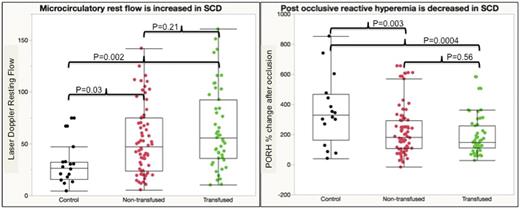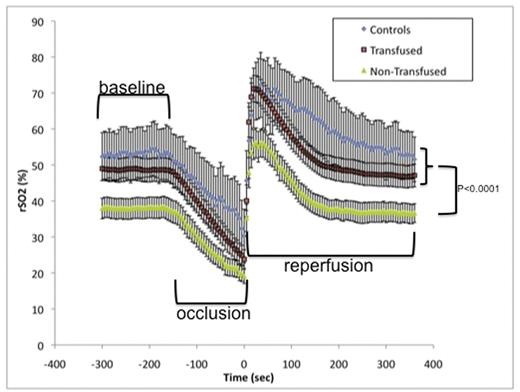Abstract
BACKGROUND: Sickle cell disease is an inheritable hemoglobinopathy that causes increased red blood cell (RBC) stiffness due to hemoglobin polymerization at low oxygen tension. This leads to microcirculatory occlusion as well as chronic hemolysis and chronic inflammation, resulting in a diffuse vasculopathy of bothmacrovascular and microvascular beds. Chronic transfusion therapy is used for both primary and secondary prevention of ischemic stroke, amacrovascular complication; however, there is limited knowledge of its effect on microvascular function.
OBJECTIVE: To determine the effects of chronic transfusion therapy on microvascular function and tissue oxygenation.
DESIGN/METHODS: We utilized a forearm, arterial and venous occlusion model, commonly used for flow-mediated dilation of the brachial artery, to simultaneously assess post occlusive reactive hyperemia (PORH) in the microcirculation and post hyperemic change in tissue oxygenation. PORH was measured using laser Doppler flowmetry placed over the third finger, proximal to the nailbed. Regional tissue oxygenation (rSO2) was measured using near infrared spectroscopy (NIRS) placed on the dorsal surface of the hand. FMD was measured using a linear ultrasound probe. Transfused patients were measured before and after a single transfusion. Kruskal-Wallis was used to test between group differences. Multivariate linear regression was used to model predictors of vascular function.
RESULTS: We enrolled 18 control (CTL) patients, 75 non-transfused (NTR) SCD patients, and 26 chronically transfused (TR) SCD patients. Consistent with our previously published data, FMD was improved but not normalized by chronic transfusion and it was predicted by ln[plasma hgb], age and sex. PORH was reduced in both SCD patient groups when compared to the control group while resting flow by laser Doppler was elevated in both SCD groups (figure 1). PORH was also inversely related to resting flow, suggesting that basal conditions in the microcirculation are significant predictors of their response to forearm occlusion. Percent change in rSO2 was not different between the three groups. Lower baseline rSO2 was inversely associated with percent rSO2 increase following hyperemia; and, the baseline rSO2 was significantly decreased in the non-transfused SCD patients but normalized in the transfused SCD patients (Figure 2). Resting hypoxia was best predicted by RBC deformability in the non-transfused patients, even after correction for hemoglobin level, whereas resting hemoglobin levels predicted hypoxia in the transfused and healthy patients.
DISCUSSION: With the goal to better understand the mechanism by which transfusion therapy decreases the risk of stroke, we tested the response to arterial and venous occlusion, simultaneously, at three different functional levels of the vascular system: 1.Conduit artery, 2.Pre-capillary arteriolar and capillary, 3.Tissue oxygen exchange. We confirm our previous findings that conduit vessel dysfunction is highly dependent on free hemoglobin, which is consistent with the hemolysis paradigm as a mechanism for sickle cell vasculopathy. This study extends our model to the microcirculation. Resting microcirculatory flow is increased in both transfused and non-transfused SCD patients; and while the resting rSO2 is near normal in the transfused SCD patients it is significantly lower in the non-transfused subjects. This creates the potential for severe hypoxia in the setting of a limited ability to augment flow through the microcirculation during periods of high demand, as in PORH. If there is also decreased conduit vessel reactivity upstream this creates the scenario over which large areas of tissue may rapidly become ischemic. This is a novel system, with simultaneous measurements in multiple vascular beds, allowing us to evaluate supply-demand matching.
CONCLUSIONS: Chronic transfusion therapy improves both brachial artery endothelial function and regional tissue oxygenation but it does not significantly improve microcirculatory function, which may be near its maximal flow at rest. Hemoglobin determines resting tissue saturation in healthy and transfused SCD patients, but high shear RBC deformability determines rSO2 in non-transfused SCD patients.
Laser Doppler resting flow is higher but post occlusive hyperemia is lower in SCD
Laser Doppler resting flow is higher but post occlusive hyperemia is lower in SCD
NIRS repsonse to forearm occlusion.
Wood:World Care Clinical: Consultancy; Vifor: Consultancy; AMAG: Consultancy; Ionis Pharmaceuticals: Consultancy; Biomed Informatics: Consultancy; World Care Clinical: Consultancy; Ionis Pharmaceuticals: Consultancy; Apopharma: Consultancy; Vifor: Consultancy; Apopharma: Consultancy; AMAG: Consultancy; Biomed Informatics: Consultancy; Celgene: Consultancy; Celgene: Consultancy.
Author notes
Asterisk with author names denotes non-ASH members.



This feature is available to Subscribers Only
Sign In or Create an Account Close Modal